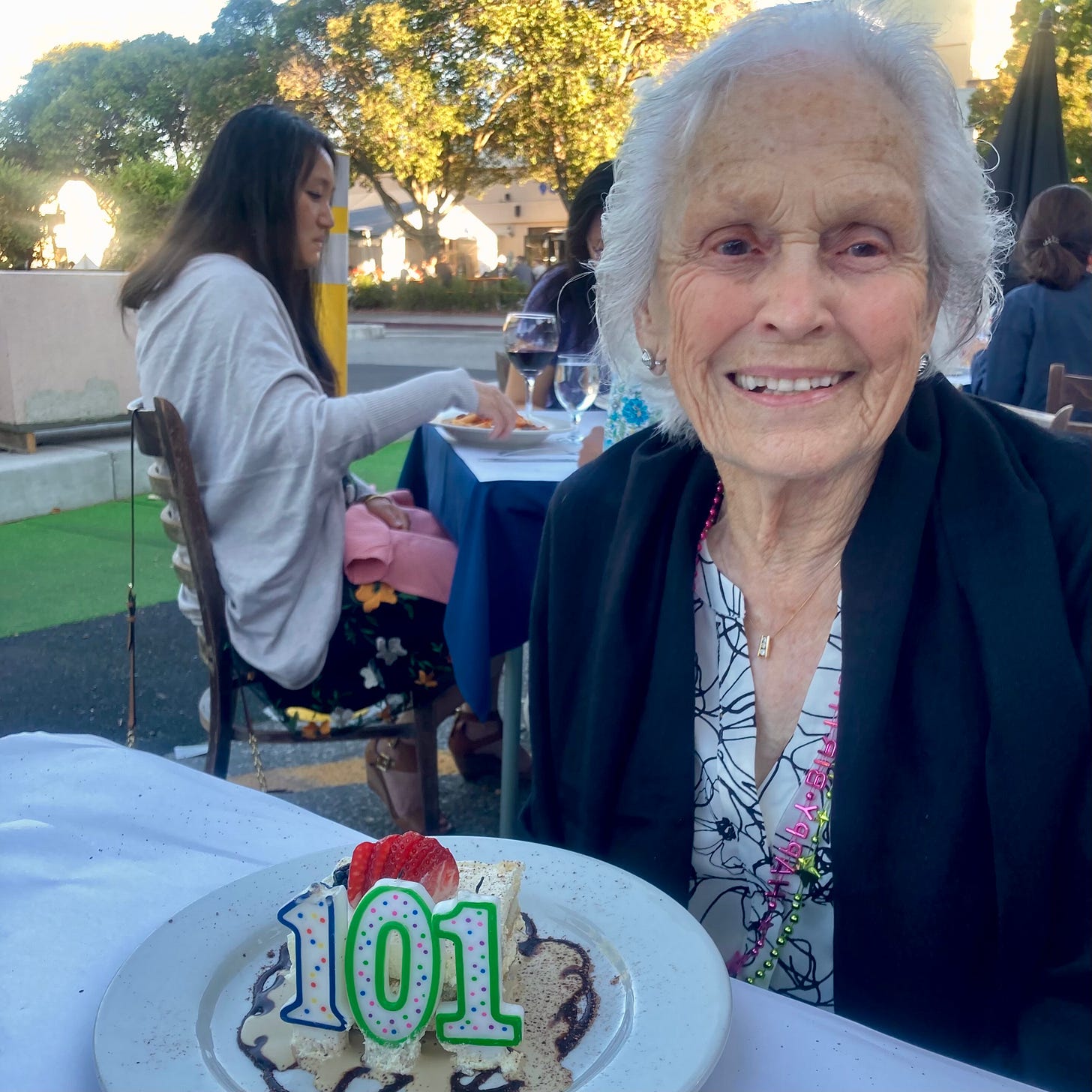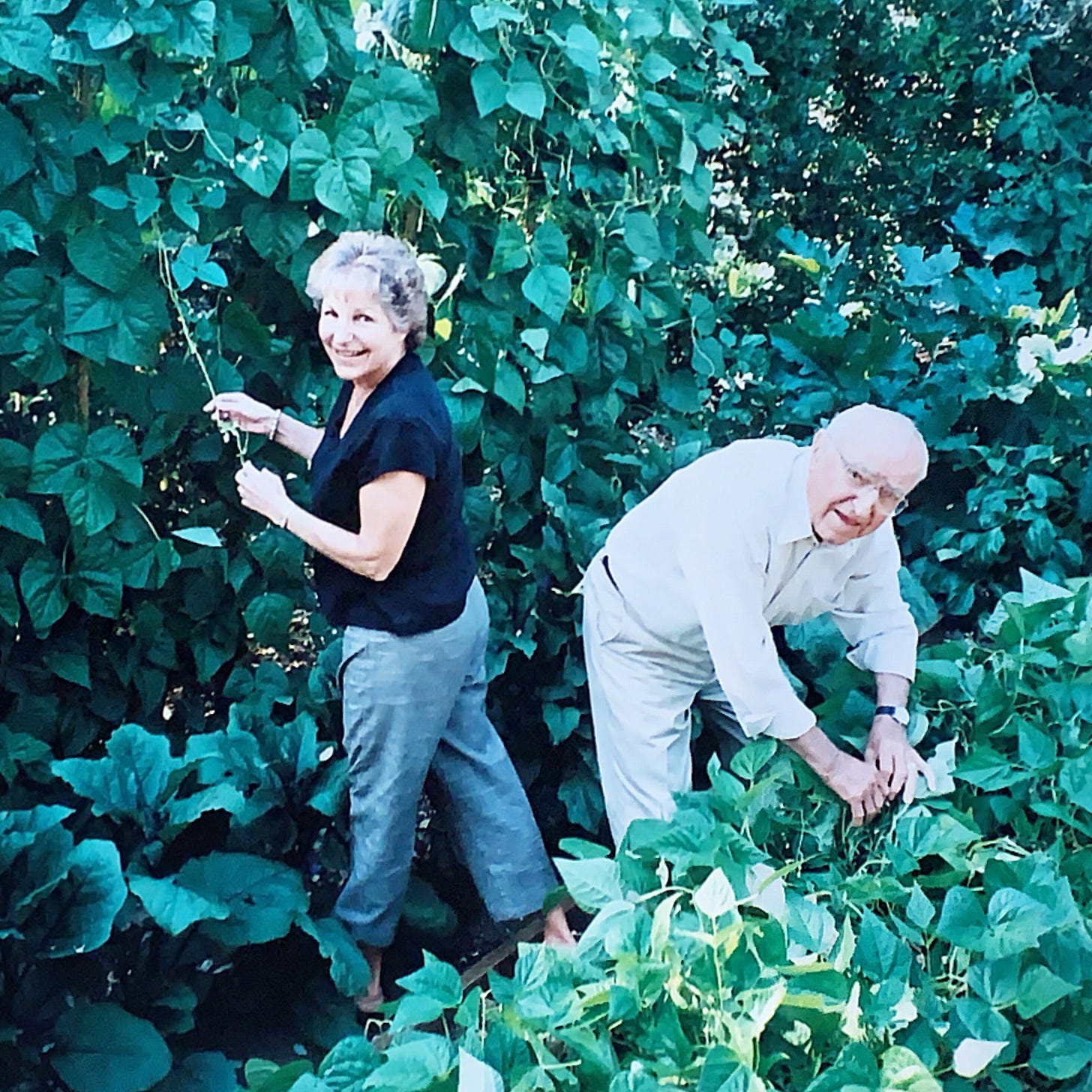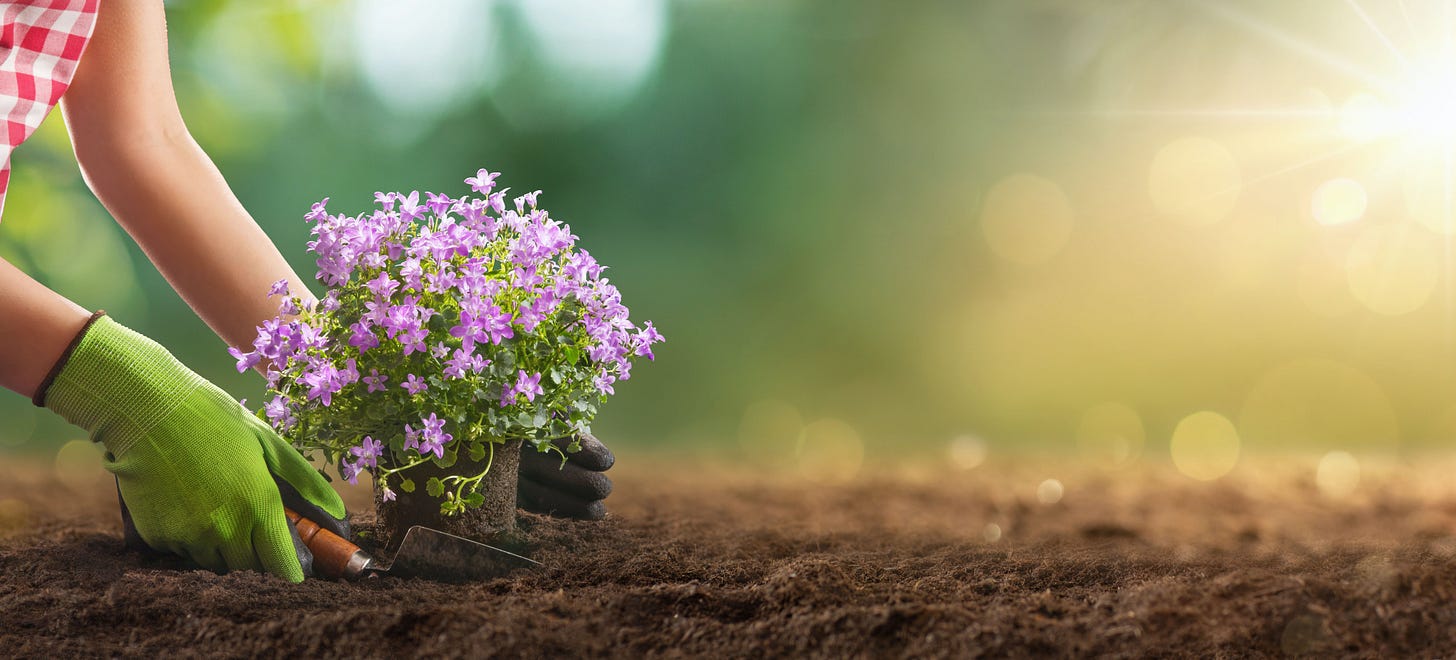The Inescapable Charm of a Concerning Hobby
Grandma Kay is quite opportunistic to choose her gardening window of time. The one hour a day she likely won’t be pestered about what she’s doing in the garden.
👋 Hello, I’m Kevin Ferguson, author of 🍷 Rain on the Monte Bello Ridge,🍷 my forthcoming memoir about health, aging and winemaking. (Read the origin story of the book.) 🍇 The Centenarian Playbook is my newsletter, which features longevity tips and stories from Grandma Kay’s long life. It also includes stories of the Gemello Winery, which her late husband, Mario, ran for nearly half a century. 📖 I’m sure you’ll find my maternal grandparents are quite lovable characters.
The Inescapable Charm of a Concerning Hobby
If Grandma Kay spots dying leaves on a bush, her neighbors are sure to catch her petite 101-year old frame in action: donning a sun hat, pushing her walker across her yard to manicure a bush.
It’s a delicate balance of low impact stress release for her and a concerning activity for the family. Images of her tumbling over in a pile of weeds with her walker out of reach troubles me among others on occasion.
She’s quite opportunistic to choose her gardening window of time. Like a 16-year-old who plots his joyride opportunity as mom and dad announce their dinner plans with another couple.
Grandma Kay keeps her gardening tools in a long sleeve-like pocket attached to her walker. As the weekend nears, she creates little piles of leaves for Stan, her Saturday gardener, to scoop up after he mows her lawn.
Occasionally, Stan calls to reschedule, causing Grandma Kay to stress. “He’s not coming til Tuesday,” she complained to me one Sunday afternoon, as if a deadline was being missed.
She has a touch of OCD, like a kitchen cabinet left ajar, if the piles are not attended to in time.
“It’s OK Grandma. It’s not a big deal if he comes Tuesday instead,” I tried to reassure her. “What’s the problem?”
“It’s OK Grandma. It’s not a big deal if he comes Tuesday instead,” I tried to reassure her. “What’s the problem?”
“It throws off my whole schedule,” she says.
Her “schedule” is her sense of what day it is. Her caregiver comes Monday thru Friday. Family members check in on weekends. My mom visits most Sundays. If my mom comes on a Wednesday, for example, to take Grandma Kay to a doctor’s appointment, she says it feels like a Sunday.
She knows some family members aren’t crazy about her gardening habits, like discarding her walker out of reach to prune a couple of bushes.
When my mom would tell her to leave the pruning to her gardener, she often snaps. “You can’t take everything away from me.”
The sting of her eye doctor telling her she couldn’t drive anymore is apparently still a raw wound.
Japan’s Centenarian Hot Spot
As we contemplated gardening alternatives that could bring as much joy to a centenarian, I stumbled upon a story that made me rethink discouraging Grandma Kay from tending to her plants.
It was a story about the thriving elderly community of Okinawa, Japan. This island is a longevity hot spot, known as a blue zone,1 containing one of the world’s highest concentration of centenarians per capita. And here’s the kicker: nearly all of Okinawa’s centenarians grow or once grew a garden, according to Dan Buettner, longevity expert and author of The Blue Zones: Lessons for Living Longer From the People Who've Lived the Longest.
The book explores the food, habits and lifestyles that contribute to the five blue zones of the world. In the U.S., centenarians represent one per 5,000 people. By contrast, Okinawa’s centenarians are more than triple that number.
Buettner notes that gardening has longevity benefits, because it’s a source of daily physical activity that exercises the body with a wide range of motions.
"Gardening is the epitome of a Blue Zone activity because it's sort of a nudge: You plant the seeds and you're going to be nudged in the next three to four months to water it, weed it, harvest it, Buettner says.2
My Mom & Grandpa Mario cutting grapevines in the backyard - 2005
Health Benefits of Gardening
Not only does gardening bring Grandma Kay joy, but now I started to realize it was her cross-training, too.
Luckily, my mom and two uncles, Mark and John, had already been actively Grandma-proofing the house and yard, such as installing railings in high-risk tumbling spots where Grandma Kay liked to tinker in her garden.
Another longevity benefit to gardening is that it’s often done in the sunlight, which provides a steady dose of Vitamin D, says Dr. Greg Plotnikoff, medical director at Minnesota Personalized Medicine.
“Your skin manufactures Vitamin D when it comes into contact with the sun. Without that Vitamin D, we increase our risk of nearly all age-related diseases including many types of cancer, high blood pressure, diabetes and even autoimmune disease, like MS (multiple sclerosis).”
Plotnikoff notes an important distinction between staying out in the sun so much that you burn, which could lead to skin caner, vs getting a moderate level of sunlight for the Vitamin D benefits.
“Insufficient Vitamin D markedly accelerates heart disease in kidney patients. For everyone without enough Vitamin D, bones become brittle, key hip and leg muscles become weak and chances of falling and breaking bones soars.”3
Gardening is also a source of stress release and can boost mood as much as exercise, according to a 2020 study by researchers at Princeton University and the University of Minnesota.4
Around the early 2000’s, my grandparents ordered the family to no longer give them gifts for holidays and their birthdays.
“That will just clutter the house with stuff you’ll have to throw out when we’re gone,” Grandpa Mario said.
Many of us disobeyed, finding it weird not to give them something. So we often reverted to giving them perishable items, like flowers or plants. Grandma Kay wound up planting some of them in her yard. Months later, she would tell me, “the chrysanthemum you gave me for Mother’s Day is growing very nicely in the front yard.”
These perishable gifts may have spawned her gardening obsession in her nineties. She grew up with a stepfather who tended the gardens and lawns of the Stanford University campus in the 1930s. But it’s hard to imagine that that had an influence on Grandma Kay. From the moment she married my grandfather in 1940 until his death in 2005, most of the Gemello gardening was done by her husband.
She did a little gardening before Mario’s passing, but during their union he did about 85% of the gardening. Mario was Mr. Home Improvement, learning the trait from his dad, who learned to tend vineyards in his native Italy as a kid. It was common for winemakers in the early 1900s to also be farmers and do-it-yourself handymen.
In 1974, my grandparents moved from Mountain View to neighboring Los Altos, into a nice two-story house. It had a long driveway on which the grandchildren could shoot hoops or play wiffle ball. But for Grandpa, the backyard was his playground. A perfect yard for a do-it-yourself hobbyist.
Initially, the backyard had a slanted lawn. A favorite memory of mine included spending hours with my cousins rolling down the hill, climbing to our feet in a dizzy haze, ready to do it again.
Party prepping in Grandpa Mario's gazebo on his 89th birthday - 09/2005
When we became too big for that, Grandpa went to work on his landscaping vision. He leveled the lawn and built a two-layer deck. The lower deck provided shade from the blazing Santa Clara valley sun. The upper deck offered a comprise for sun-worshipers and skin-cancer-conscious guests. The latter could hangout underneath the pergola or gazebo.
Since the property was situated on a hill slope, Mario designed steps throughout the backyard. Two steps down to exit the deck on one side. Five steps on the other. Just west of the deck, two concrete steps provided a foundation for the redesigned lawn. A walking path and the concrete steps wrapped around the gazebo like a mini amphitheater.
All in all, it’s a beautiful design, but it’s become an obstacle course for a walker-pushing 101-year-old, who has always been resistant to downsize. Grandma Kay’s fear of losing the memories of where the grandchildren played lawn croquet or kicked the soccer ball around have always been too great for her to give up in a move. Not to mention her new found love of planting, nurturing and caring for her precious gifts from her children and grandchildren.
Blue Zone Origin: Calling some regions of the world with high concentration of centenarians “blue zones” grew out of the demographic work done by Gianni Pes and Michel Poulain published in the Journal of Experimental Gerontology. Pes and Poulain drew concentric blue circles on the map of Sardinia, an island off the coast of Italy. They noticed some villages there had the highest concentration of male centenarians. They began to refer to this area inside the circle as the blue zone. Building on that demographic work, Dan Buettner, a National Geographic Fellow, pinpointed other longevity hotspots around the world and dubbed them blue zones.
McPhillips, Kells, “This One Activity Ticks Off 3 of the Blue Zones’ Markers of Longevity,” Well+Good Magazine, 7/12/20
Buettner, Dan, The Blue Zones: Lessons for Living Longer From the People Who've Lived the Longest, page 100
Samin, Nosrat, “Gardening Made Me Happier. It Will Work For You Too,” 7/15/20, NY Times magazine






Love this!
Thanks Kristen! I really appreciate it. 😀